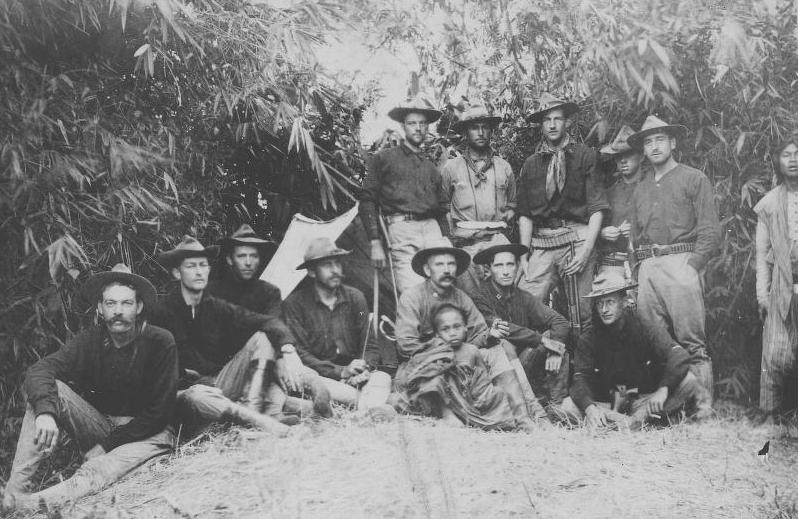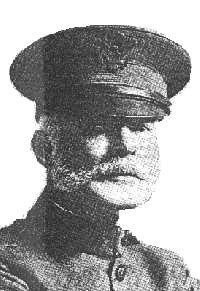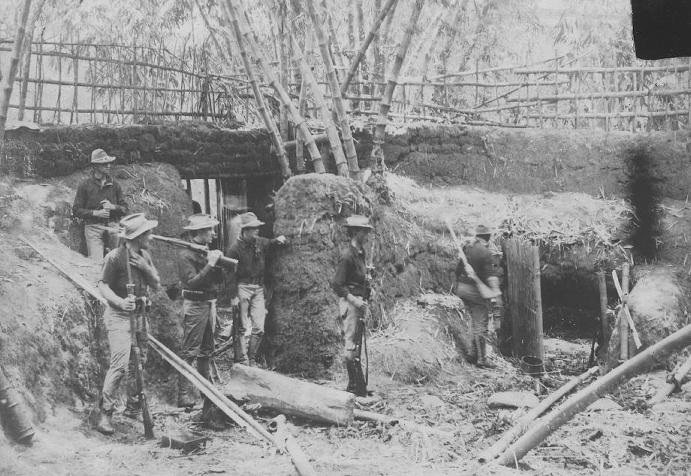![]() 1st Battalion 22nd Infantry
1st Battalion 22nd Infantry ![]()
The Third Sulu Expedition
![]()
Campaign Streamer awarded to the 22nd Infantry for its service in Jolo 1905
The Third Sulu Expedition
April 21, 1905, pursuant to telegraphic
instructions from Department Headquarters, a provisional
battalion was organized for service on Jolo.
The battalion was formed of Companies A, D, and E, totalling 160
men, 1st Lieutenant and Assistant Surgeon Orville G. Brown, one
sergeant
and five privates of the Hospital Corps. At the same time a
provisional company was sent to Jolo from Cudurangan.
The Provisional Battalion, 22nd Infantry, under
Major Abner Pickering, left Camp Keithley at 5:40 P. M. April 21,
concentrated at Camp Overton
April 22, and left the latter station the same day on the steamer
Romulus, accompanied by two troops of the 14th Cavalry
under Major F. H. Hardie.
This was officially known as the Third Sulu Expedition. Two days
later the command disembarked at Jolo, and, marching to Asturias
Barracks,
went into camp. On the 26th the Provisional Company from
Cudurangan arrived on the steamer Sabah and joined the
expedition.
The operations which followed were of considerable importance,
and for that reason the names of the officers accompanying the
expedition
are here listed in full:
Major Abner Pickering, Commanding.
1st Lieut. and Battalion Adjutant Henry L. Harris, Jr. Adjutant.
2nd Lieutenant and Battalion Q. M. and Commissary E. L. Ball, Q.
M.
1st Lieutenant and Assistant Surgeon Orville G. Brown, Surgeon.
Company A; 2nd Lieutenant R. V. Venable and 56 men.
Company D; Captain Orrin R. Wolfe, 2nd Lieutenant Charles B.
Moore, and 61 men.
Company E; Captain George N. Bomford, 2nd Lieutenant Morton
Russell, and 55 men.
Provisional Company; Captain Daniel G. Berry, 1st Lieutenant
Sydney Smith, 2nd Lieutenant J. J. Burleigh,
2nd Lieutenant M. H. Thomlinson, and 97 men.
The total strength of this force was 13
officers and 279 men. The Commanding General of the Philippine
Department took personal command
of the expedition, and divided it into four columns, the
Provisional Battalion of the 22nd Infantry constituted the entire
third column.

Soldiers of the 22nd Infantry in the
Philippines.
Standing, 4th from right holding shotgun is LT Parker Hitt
From the Parker Hitt photograph collection, University of Michigan
Early on the morning of May 1, the command
marched out toward Ipil, the first objective. At 8:30 A. M., in
the Tambang Market,
the troops were fired upon by hostile Moros, and Private Samuel
Weaver, of the Provisional Company, was mortally wounded.
This resistance was quickly overcome and the march resumed to
Suliman, where camp was made for the night.
The march was again taken up the next morning with the
Provisional Battalion acting as rearguard. At 1:00 P. M., firing
being heard from the right
and rear of the column, Major Pickering was sent back with
Companies A and D, 22nd Infantry. Pickering found Scott's Cavalry
engaged in a skirmish with the Moros, ordered the cavalry
withdrawn, and sent Lieutenant Harris with Company D, to cover
the withdrawal.
The latter mission was made particularly difficult by the nature
of the terrain, which made intelligent reconnaissance practically
impossible.
In the meantime General Leonard Wood reached
the scene with the Provisional Company of the 22nd Infantry and a
field gun.
Companies A and D of the 22nd, and Troop I, 14th Cavalry, were
moved off to the right of the position in order to cut off a
possible line of retreat
for the enemy. The single field piece was brought into action
without delay, but the thickness of the woods completely
prevented any observation
of the effect of its fire.
At dusk, Companies A and D were recalled, and
orders issued for Major Pickering to take the enemy's position by
assault.
The troops designated for the attack were Companies A and D, 22nd
Infantry, supported by Troop I, 14th Cavalry,
with the Provisional Company, 22nd Infantry, in reserve.
Lieutenants Venable and Thomlinson led Company A; Captain Wolfe
and Lieutenant Moore, Company D; Captain Berry and Lieutenants
Smith and Burleigh, the Provisional Company. A slow, but steady
advance
through the thick underbrush was carried on until resistance was
met in the form of a bamboo fence, which had been erected by the
Moros
as part of their defences. Company A took up a position parallel
to this fence and opened a heavy fire on the enemy's line, while
Company D
was placed in the firing line at right angles to Company A, this
in order to outflank the enemy's left. About thirty minutes after
the action commenced,
the enemy's fire weakened perceptibly, and it became apparent
that the time had arrived for an assault in force.
Accordingly the provisional company was brought
up and placed in line. As soon as the troops began moving forward
the Moro defense broke,
and the fight was brought to a decisive conclusion. The body of
Utig, with those of fifty-three of his followers, was found in
the underbrush
near his foremost defensive position. The American loss in the
action totaled two killed and thirteen wounded.
On June 4, 1905, orders were issued heartily
commending the services of the provisional battalion of the 22nd
Infantry during the expedition.
Lieutenant Harry L. Harris, Jr., the battalion adjutant, was
mentioned for conspicuous gallantry in action, and Sergeant
(First Class) James C. Gunn,
Hospital Corps, received a recommendation for the Certificate of
Merit.
(Ed., In 1932 Abner Pickering would be awarded
a Silver Star Medal for his actions at Peruka Utig's cotta on May
3, 1905.
The award of the medal was based on a citation for gallantry to
Pickering in the engagement at Utig's cotta which was published
in
General Orders No. 43 Department of Mindanao dated December 31,
1905.)
Following are the casualties suffered by the 22nd Infantry in the course of the expedition:
Killed in Action:
Private Eary E. Sansoucie, Company A.
Corporal Daniel Newport, Company F.
(Note: In the 1922 Regimental history the name
of Private Eary E. Sansoucie
was incorrectly entered as Eary E. Lanconcy.)
Died of Wounds:
Private Elick Howell, Company B.
Private Howard Glasgow, Company C.
Private Samuel Weaver, Company G.
Wounded:
First Class Sergeant James C. Gunn, Hospital Corps.
Private Nelson R. Hughes, Company A.
Private William Ayer, Company A.
Private Elmer E. Gore, Company A.
Private George C. Buck, Company B.
Private Joseph A. Adams, Company B.
Private James W. Wild, Company C.
Private James J. Stamates, Company D.
Musician Jacob Orken, Company I.
Corporal Luther Jessup, Company L.
Corporal Frederick K. Paul, Company M.
Years after the event, 1st Lieutenant
Henry L. "Harry" Harris, Jr. , mentioned above for
conspicuous gallantry in action,
was awarded the Distinguished Service Cross for his actions
during the 3rd Sulu expedition.
Henry L. Harris Jr. Graduation portrait U.S. Military Academy 1899 Looking very much like he would
have at the date of his |
-- |
The Distinguished Service Cross |
Henry Leavenworth Harris Jr. was the
third in his family to graduate from the US Military Academy at
West Point. His grandfather
Nathaniel Sayre Harris graduated in 1825 and his father Henry
Leavenworth Harris graduated in 1869. Henry L. Harris Jr. was
born on
August 20, 1875 and graduated in 1899 when he was commissioned a
2nd Lieutenant in the 20th Infantry. After his promotion to 1st
Lieutenant
of the 10th Infantry in 1900, he commanded four companies of
Ilocano Scouts in the Philippines in 1901. He was transferred to
the 22nd Infantry
on February 4, 1903, and at the end of that year sailed with the
Regiment to the Philippines. He served with the 22nd Infantry
until July 17, 1905,
when he tendered his resignation from the Army. On June 18, 1907
he was offerred a commission as a 2nd Lieutenant in the 6th Field
Artillery,
which he accepted on July 23 of that year. In 1908 he was
promoted to 1st Lieutenant in the 3rd Field Artillery, and while
in command of a work detail
he met with an accident which resulted in the loss of his left
leg. He was retired from the Army as a 1st LT with a disability
in the line of duty on June 16, 1909.
In September 1917 he was recalled to active duty at the
recruiting station at Scranton, PA. He was detailed to
Quartermaster duty in 1918 with the
temporary rank of Captain, and served as the Executive Officer of
the Quartermaster General Supply Depot at Newport News, VA, until
October 15, 1919,
when he was ordered to Scranton, PA., as assistant to the
Recruiting Officer there, until March 31, 1920. He was again
recalled to active duty
from March 3 to July 18, 1921. Harris was carried on the
unlimited retirement list until June 21, 1930, when he was fully
retired with the rank of Captain.
He died on November 6, 1957.

Henry Leavenworth Harris, Jr.
Photo taken during World War I.
Photo from The History of Fort Tilden, NY website
In 1922 a battery of two 16 inch guns
at Fort Tilden, New York, was named for Henry L. Harris, Jr.
For photos and details of Battery Harris, click on the following
link:
The History of Fort Tilden, NY
The citation for the award of the Distinguished Service Cross to Henry L. Harris, Jr., reads:

June 4, 1905, after burying the dead with
appropriate honors, the command marched to Ipil, and the
following day proceeded to Pala's territory.
His cotta was captured and Companies A and B and the provisional
company established in camp as a guard over the equipment and
supplies.
Company E was dispatched as a guard over an intrenched crater.
A great deal of hardship was encountered by the
troops at this time on account of the difficulty in obtaining
suitable drinking water.
One hundred and fifty filled canteens were sent by the men left
at Ipil to those in the forward positions. Of these, only seventy
were recovered,
and a terrible shortage of water for the former troops resulted,
many of the men becoming completely exhausted from the enforced
lack of water.
June 6, the march was resumed to Tubig Bilaam, and on the 9th to
Kansukan, where Orangcay Hatai surrendered forty-two rifles
and one hundred and eighty men. The rifles were taken over by
Captain Berry with detachments of the provisional company, 22nd
Infantry,
and the provisional company, 17th Infantry.
The return march to Jolo was made via Liet
lake, where camp was made on the night of the 12th of June. The
following night was spent at Suliman,
and on June 14th, the command went into quarters at Asturias
barracks.
Companies A and E embarked on the 20th, and
sailed the next day for Malabang. Thence they marched to Vicars,
and from there proceeded on the gunboats Flake and Almonte
to Camp Keithley, arriving June 24.
The provisional company, in the meantime, remained at Jolo.
The day following the arrival of the column at
Camp Keithley, Quartermaster Sergeant John C. De Ginther was
killed in a personal quarrel
with two Moros, both the Moros being wounded. This was the only
item of interest occurring during the remainder of the month of
June and in July.
The provisional company was relieved from duty at Jolo July 5,
proceeded immediately to Camp Keithley and was disbanded on the
8th.
September 1, 1905, forty native convicts,
employed at hard labor on the Pouton-Marahui road, overpowered
their guards and made their escape.
Troops were ordered in pursuit of these men and two detachments
of the 22nd Infantry were organized for this purpose. The first
of these
consisted of Captain Lawrence A. Curtis, Second Lieutenant
Venable and twenty men from each of Companies A and F. The second
was made up of Second Lieutenants Max B. Garber and B. B.
McCroskey, and twenty men from each of Companies L and G.
The search for the escaped convicts was carried on for three
days, at the end of which time, no trace of them having been
found,
the troops were returned to their station.
During the month of September, 1905, a great
amount of triangulation and surveying was completed by a
detachment of twelve men
of the 22nd Infantry under First Lieutenant Solomon B. West. This
had to be done under an almost incessant fire from parties of
hostile Moros,
and great credit is due Lieutenant West and his men for their
successful efforts in this direction.
On June 22, 1905, orders were received
directing the relief of the 22nd Infantry by the 15th Infantry.
Events of the near future, however, prevented the order from
taking effect.

Soldiers of the 22nd Infantry inside a
Moro cotta.
Note the bamboo, mud brick and earth construction, and the fixed
bayonets of several of the Soldiers.
On the far left, half out of the picture is a lantaca, a small
caliber smooth bore cannon used by the Moros.
Photo from the Parker Hitt photograph collection, University of Michigan
Narrative taken from the 1922 Regimental History
Home | Photos | Battles & History | Current |
Rosters & Reports | Medal of Honor | Killed
in Action |
Personnel Locator | Commanders | Station
List | Campaigns |
Honors | Insignia & Memorabilia | 4-42
Artillery | Taps |
What's New | Editorial | Links |